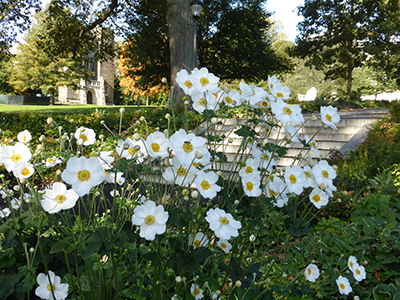
Plants of the Month: Anemone x hybrida ‘Honorine Jobert’

photo credit: J. Coceano
For me, the arrival of fall brings a bittersweet feeling. Gone are the long, sunny days, replaced by shorter days and brisk nights, signaling to plants that winter is coming. Despite the sad emotions associated with this shift, a bevy of autumnal delights arise in the garden, giving a sense of awe to a season otherwise marked by endings. Blue, yellow, and white flowers dominate the floral palette, and ornamental grasses come into their moment of glory. With these sights, I find my melancholy mood replaced by joyous wonderment.
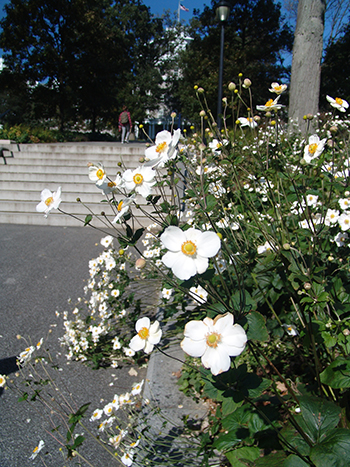
Japanese anemones possess an air of elegance. photo credit: R. Robert
One such fall-flowering beauty I have long been enamored of is the Japanese anemone, specifically Anemone x hybrida ‘Honorine Jobert’, a cultivar offering lovely white, camellia-like blooms. Anemone x hybrida is a group of anemones produced by crossing two or three species of A. hupehensis, A. vitifolium, and A. tomentosa. These species are native to China, though long cultivated in Japan, so the common name of Japanese anemone is somewhat imprecise. Japanese anemones possess an air of elegance which really strikes my fancy. The attractive foliage, tantalizing globular buds, and dignified flower cymes are all delightful to my eye.
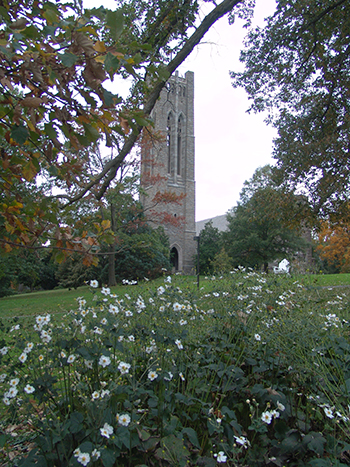
Before the flowers of A. x hybrida ‘Honorine Jobert’ appear, it already holds its own in the garden, offering handsome foliage that plays well with other part-shade companions. photo credit: R. Robert
As the summer begins to fade, A. x hybrida ‘Honorine Jobert’ kicks into high gear, blooming from August through September, showing impressive continuous blooms. These blooms are invaluable by filling the gap before many asters, chrysanthemums, and delphiniums take the stage. Yet, before the flowers of A. x hybrida ‘Honorine Jobert’ appear, it already holds its own in the garden, offering handsome foliage that plays well with other part-shade companions.
A. x hybrida ‘Honorine Jobert’ mixes well with the similar foliage of Astilbe or Actaea and also bolder foliage such as Hosta. Leaves are trifoliate, palmate, dark green, forming dense, neat mounds of foliage. Plants spread by shallow, creeping rhizomes and can become somewhat aggressive. Easily divided, this plant can be spread to new areas of the garden or shared with friends when a clump becomes too large for your liking. A. x hybrida ‘Honorine Jobert’ looks excellent when planted en masse, so for me the spread of this plant is welcome. Foliage typically grows 2-3’, though when in flower the plants reach closer to 4’ with their tall flower stalks.
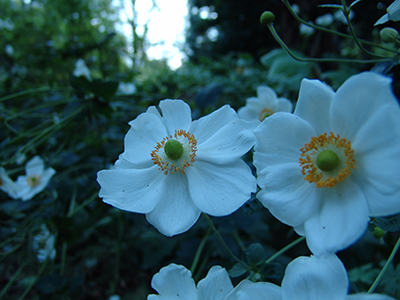
The flowers of Anemone x hybrida ‘Honorine Jobert’ feature single to semi-double overlapping white tepals (the petals and sepals are indistinguishable), and abundant orange-yellow stamens surrounding a chartreuse pistil. photo credit: R. Robert
The flowers of Anemone x hybrida ‘Honorine Jobert’ feature single to semi-double overlapping white tepals (the petals and sepals are indistinguishable), and abundant orange-yellow stamens surrounding a chartreuse pistil. As the stamens are lost, the rounded seed head is left atop the flowering stem, like a small pincushion. This, along with the spherical, somewhat egg-shaped buds, provides additional interest to the impressive display of the 2-3” wide, open-face flowers.
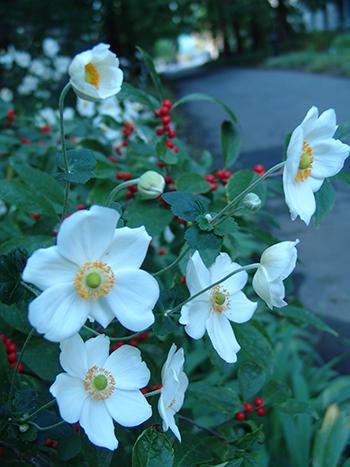
The white flowers do an excellent job brightening up a part-shade garden, accentuating the brightly colored stamens. photo credit: R. Robert
The white flowers do an excellent job brightening up a part-shade garden, accentuating the brightly colored stamens. Flowers are borne on tall stalks high above the foliage, which wave carelessly with the breeze, seemingly unmindful of the imminent arrival of winter. Due to this effect (and I would add a breezy disposition) this plant is sometimes referred to as windflower.
Anemone x hybrida is not simply carefree in appearance; it is quite versatile regarding growing conditions, performing well in full sun and shade, with light shade being ideal. Moist soil is appreciated; wet, poorly-drained soil is unsuitable. Plants can become stressed by hot, dry conditions, so in the south they should be sited in more shade, while in cooler climates, more sun is preferred.
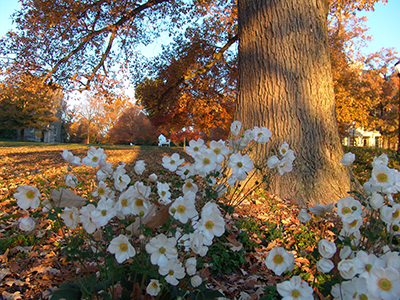
The many positive attributes of this anemone have garnered it the honor of the 2016 Perennial Plant Association’s Perennial of the Year. photo credit: R. Robert
Though hardy to zone 4, this plant appreciates a protected setting and/or winter mulch in colder climates. Overall, this plant is very easy to grow and requires little maintenance. The many positive attributes of this anemone have garnered it the honor of the 2016 Perennial Plant Association’s Perennial of the Year.
A x. hybrida is quite versatile in terms of its garden use as well: it looks great in perennial borders, in a cottage garden, and in modern landscapes. Consider planting it near the front of the garden, where the low, mounded foliage can be appreciated throughout the season. Placement in and amongst other low, foliage plants (actaea, astilbe, hosta) and other fall-blooming plants enhance its beauty.
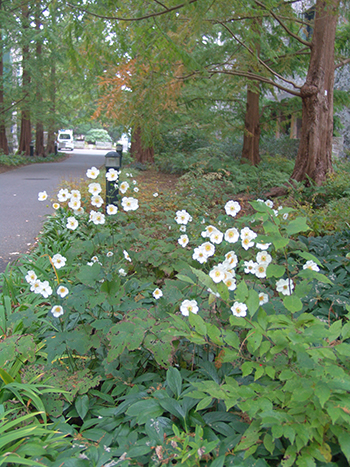
A. x hybrida ‘Honorine Jobert’ plants are sited in the part-shade setting of the Metasequoia Allée, where the bright white booms really catch the eye. photo credit: R. Robert
Plants featuring white variegation play well off the dark foliage and white flowers of A. x hybrida ‘Honorine Jobert’, as do ornamental grasses and meadow plants which correspond with its bloom period. A. x hybrida ‘Honorine Jobert’ plants are sited in the part-shade setting of the Metasequoia Allée, where the bright white booms really catch the eye. Consider A. x hybrida and other Japanese anemone types the next time you go plant shopping; you simply can’t go wrong with this plant!





No Comments